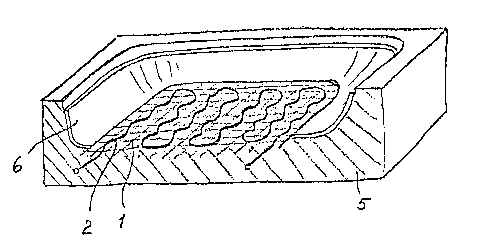Une partie des informations de ce site Web a été fournie par des sources externes. Le gouvernement du Canada n'assume aucune responsabilité concernant la précision, l'actualité ou la fiabilité des informations fournies par les sources externes. Les utilisateurs qui désirent employer cette information devraient consulter directement la source des informations. Le contenu fourni par les sources externes n'est pas assujetti aux exigences sur les langues officielles, la protection des renseignements personnels et l'accessibilité.
L'apparition de différences dans le texte et l'image des Revendications et de l'Abrégé dépend du moment auquel le document est publié. Les textes des Revendications et de l'Abrégé sont affichés :
| (12) Brevet: | (11) CA 1276963 |
|---|---|
| (21) Numéro de la demande: | 1276963 |
| (54) Titre français: | ELEMENT CHAUFFANT PLAN POUR INCORPORATION AU SIEGE D'UN VEHICULE |
| (54) Titre anglais: | FLAT HEATER FOR INCORPORATION IN SEATS OF VEHICLES |
| Statut: | Périmé et au-delà du délai pour l’annulation |
| (51) Classification internationale des brevets (CIB): |
|
|---|---|
| (72) Inventeurs : |
|
| (73) Titulaires : |
|
| (71) Demandeurs : |
|
| (74) Agent: | NORTON ROSE FULBRIGHT CANADA LLP/S.E.N.C.R.L., S.R.L. |
| (74) Co-agent: | |
| (45) Délivré: | 1990-11-27 |
| (22) Date de dépôt: | 1988-02-08 |
| Licence disponible: | S.O. |
| Cédé au domaine public: | S.O. |
| (25) Langue des documents déposés: | Anglais |
| Traité de coopération en matière de brevets (PCT): | Non |
|---|
| (30) Données de priorité de la demande: | ||||||
|---|---|---|---|---|---|---|
|
ABSTRACT
FLAT HEATER FOR INCORPORATION IN SEATS OF VEHICLES
Improved vehicle seats can be made in a process in
which the seat-covering material and a flat heater are
inserted into a negative mold for a vehicle seat and the
mold is filled with in-situ foam because the flat carrier
for the heating conductor of the heater is constituted by
a braided wide-mesh grid made of plastic strings or
plastic yarns, which during the filling of the negative
mold for vehicle seats with in-situ plastic foam are
surrounded by the foam substantially without a change of
the porosity of the plastic foam.
Note : Les revendications sont présentées dans la langue officielle dans laquelle elles ont été soumises.
Note : Les descriptions sont présentées dans la langue officielle dans laquelle elles ont été soumises.

2024-08-01 : Dans le cadre de la transition vers les Brevets de nouvelle génération (BNG), la base de données sur les brevets canadiens (BDBC) contient désormais un Historique d'événement plus détaillé, qui reproduit le Journal des événements de notre nouvelle solution interne.
Veuillez noter que les événements débutant par « Inactive : » se réfèrent à des événements qui ne sont plus utilisés dans notre nouvelle solution interne.
Pour une meilleure compréhension de l'état de la demande ou brevet qui figure sur cette page, la rubrique Mise en garde , et les descriptions de Brevet , Historique d'événement , Taxes périodiques et Historique des paiements devraient être consultées.
| Description | Date |
|---|---|
| Inactive : CIB de MCD | 2006-03-11 |
| Inactive : CIB de MCD | 2006-03-11 |
| Le délai pour l'annulation est expiré | 2003-11-27 |
| Lettre envoyée | 2002-11-27 |
| Inactive : TME en retard traitée | 1999-12-08 |
| Inactive : TME en retard traitée | 1999-12-08 |
| Inactive : TME en retard traitée | 1999-12-08 |
| Accordé par délivrance | 1990-11-27 |
Il n'y a pas d'historique d'abandonnement
| Type de taxes | Anniversaire | Échéance | Date payée |
|---|---|---|---|
| TM (catégorie 1, 7e anniv.) - petite | 1997-11-27 | 1997-11-13 | |
| TM (catégorie 1, 8e anniv.) - petite | 1998-11-27 | 1998-11-09 | |
| TM (catégorie 1, 9e anniv.) - petite | 1999-11-29 | 1999-12-08 | |
| Annulation de la péremption réputée | 1999-11-29 | 1999-12-08 | |
| TM (catégorie 1, 10e anniv.) - petite | 2000-11-27 | 2000-09-12 | |
| TM (catégorie 1, 11e anniv.) - petite | 2001-11-27 | 2001-11-02 |
Les titulaires actuels et antérieures au dossier sont affichés en ordre alphabétique.
| Titulaires actuels au dossier |
|---|
| WARME- UND ELEKTROTECHNIK B. RUTHENBERG GMBH |
| Titulaires antérieures au dossier |
|---|
| BODO RUTHENBERG |
| GUNTER LORENZEN |